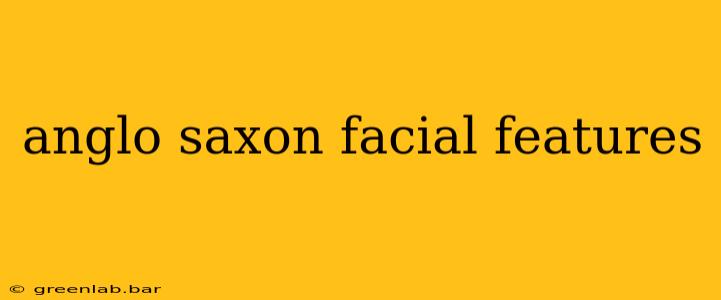The term "Anglo-Saxon" evokes images of a specific physical type, often conjured from historical art and literature. However, defining "Anglo-Saxon facial features" is surprisingly complex, demanding a nuanced understanding of history, genetics, and the limitations of historical representations. This post delves into the realities and misconceptions surrounding the physical appearance of the Anglo-Saxons.
The Challenges of Defining "Anglo-Saxon" Appearance
Defining Anglo-Saxon facial features is tricky for several reasons:
-
Genetic Diversity: The Anglo-Saxons weren't a homogenous group. Their population comprised various Germanic tribes migrating to Britain, each with its own distinct genetic makeup. Influences from pre-existing British populations further complicated the genetic mix. Therefore, a single "Anglo-Saxon look" is an oversimplification.
-
Limited Reliable Evidence: Artistic depictions from the Anglo-Saxon period—illuminated manuscripts, sculpture, and metalwork—are stylized and often symbolic. These representations don't offer a precise record of physical appearances. The artistic conventions of the time may have prioritized symbolic meaning over realistic portrayal.
-
Evolution Over Time: The Anglo-Saxon period spanned centuries (roughly 450-1066 AD). Genetic shifts and intermarriage with other populations across generations would have altered physical characteristics significantly throughout this period.
What Historical Sources Suggest
While precise facial features remain elusive, some inferences can be made:
-
Possible Germanic Traits: Based on archaeological findings and comparisons with other Germanic populations of the time, certain traits might have been more common: fair or light skin, light to brown hair, and eyes ranging from light blue to hazel or brown. However, this is far from definitive, and variation was undoubtedly widespread.
-
Regional Variations: Significant regional differences likely existed. The Anglo-Saxon population wasn't uniformly distributed across Britain. Genetic drift and local intermingling would have led to diverse appearances across different parts of the country.
Debunking Common Misconceptions
Many popular images of Anglo-Saxons perpetuate inaccurate stereotypes:
-
The "Uniform Look": Avoid thinking of a singular, stereotypical Anglo-Saxon face. The population was diverse, and attempts to create a single prototype are misleading.
-
Overemphasis on Artistic Depictions: Remember that medieval art styles often prioritized symbolism over accurate representation of physical appearance. Don't rely solely on these images to understand the reality of Anglo-Saxon looks.
Modern Genetic Studies and the Anglo-Saxon Legacy
Modern genetic studies offer a more nuanced perspective, although they're still limited in providing direct visual information. These studies can help trace the genetic lineages and migrations that contributed to the Anglo-Saxon population. However, inferring specific facial features from genetic data is currently not possible with sufficient accuracy.
Conclusion: The Elusive Anglo-Saxon Face
Pinpointing specific Anglo-Saxon facial features is impossible with certainty. The diverse origins, limited reliable historical records, and the passage of time render any single description unreliable. The reality was a far more complex tapestry of appearances than often portrayed. Instead of seeking a monolithic "look," we should appreciate the rich and multifaceted genetic heritage that shaped the Anglo-Saxon population. Focusing on the historical context, archaeological evidence, and the inherent genetic diversity of any large population provides a more accurate and nuanced understanding.

